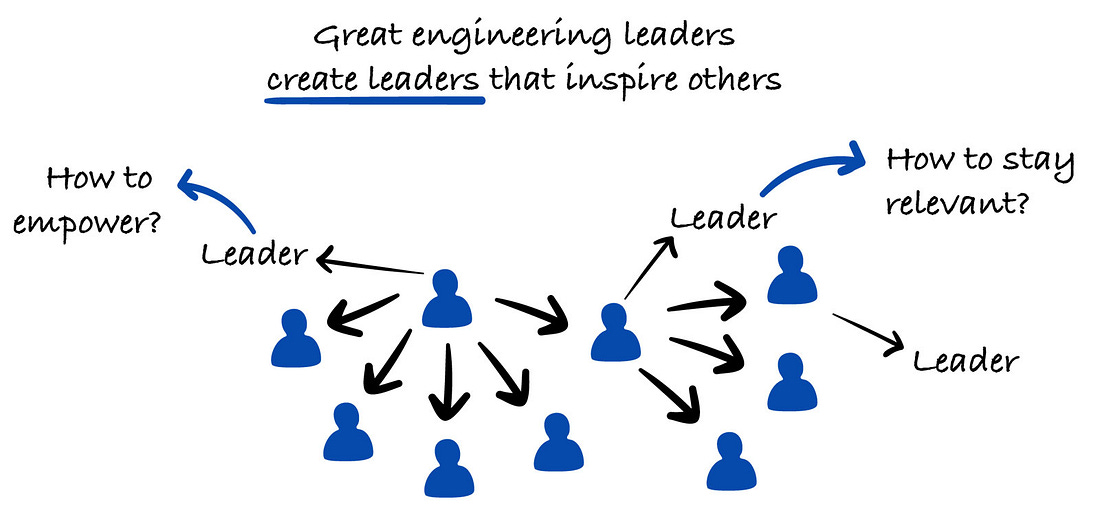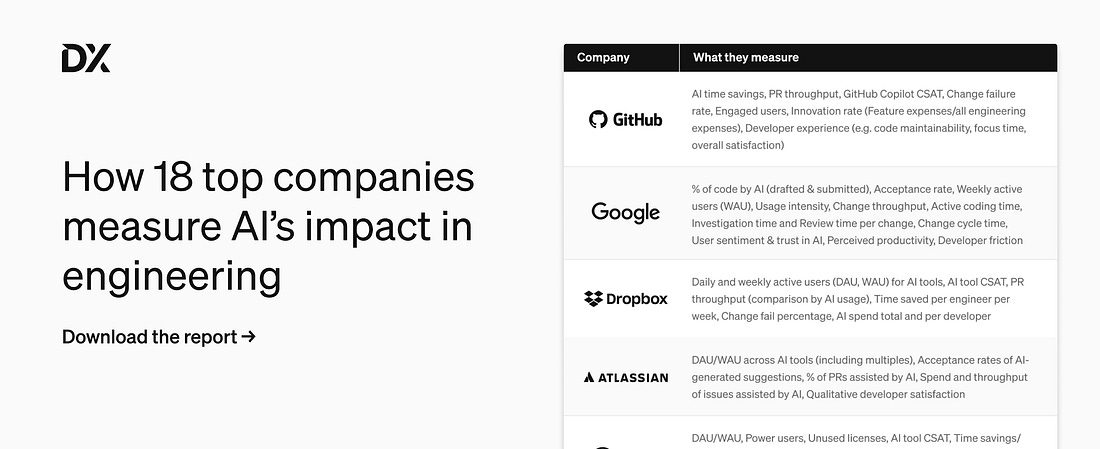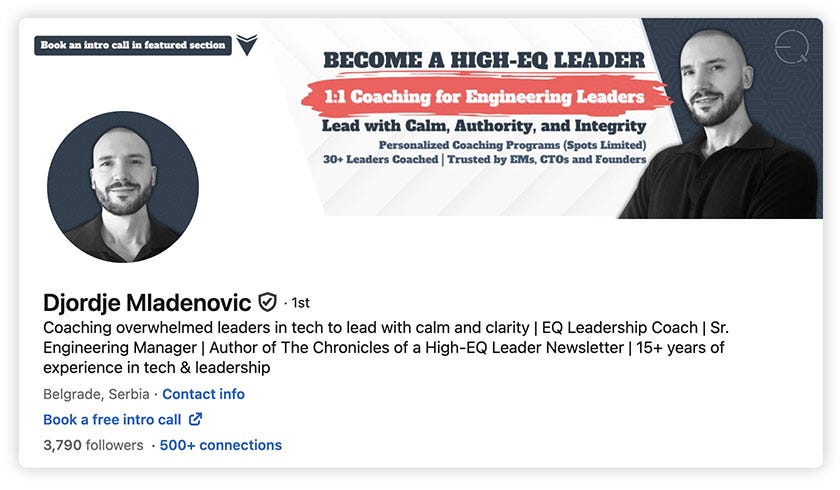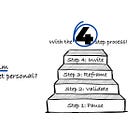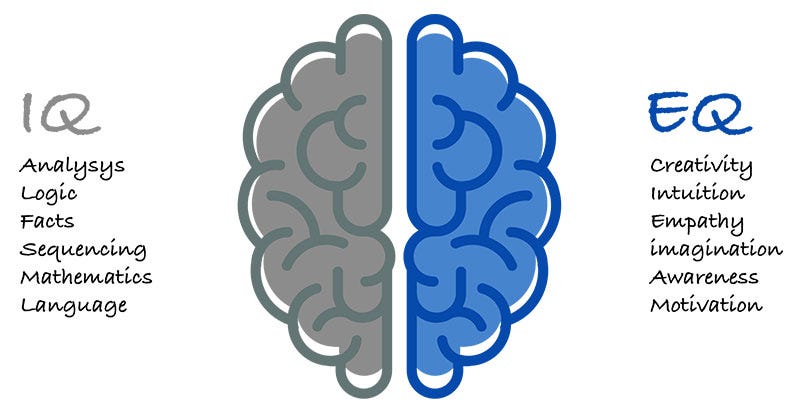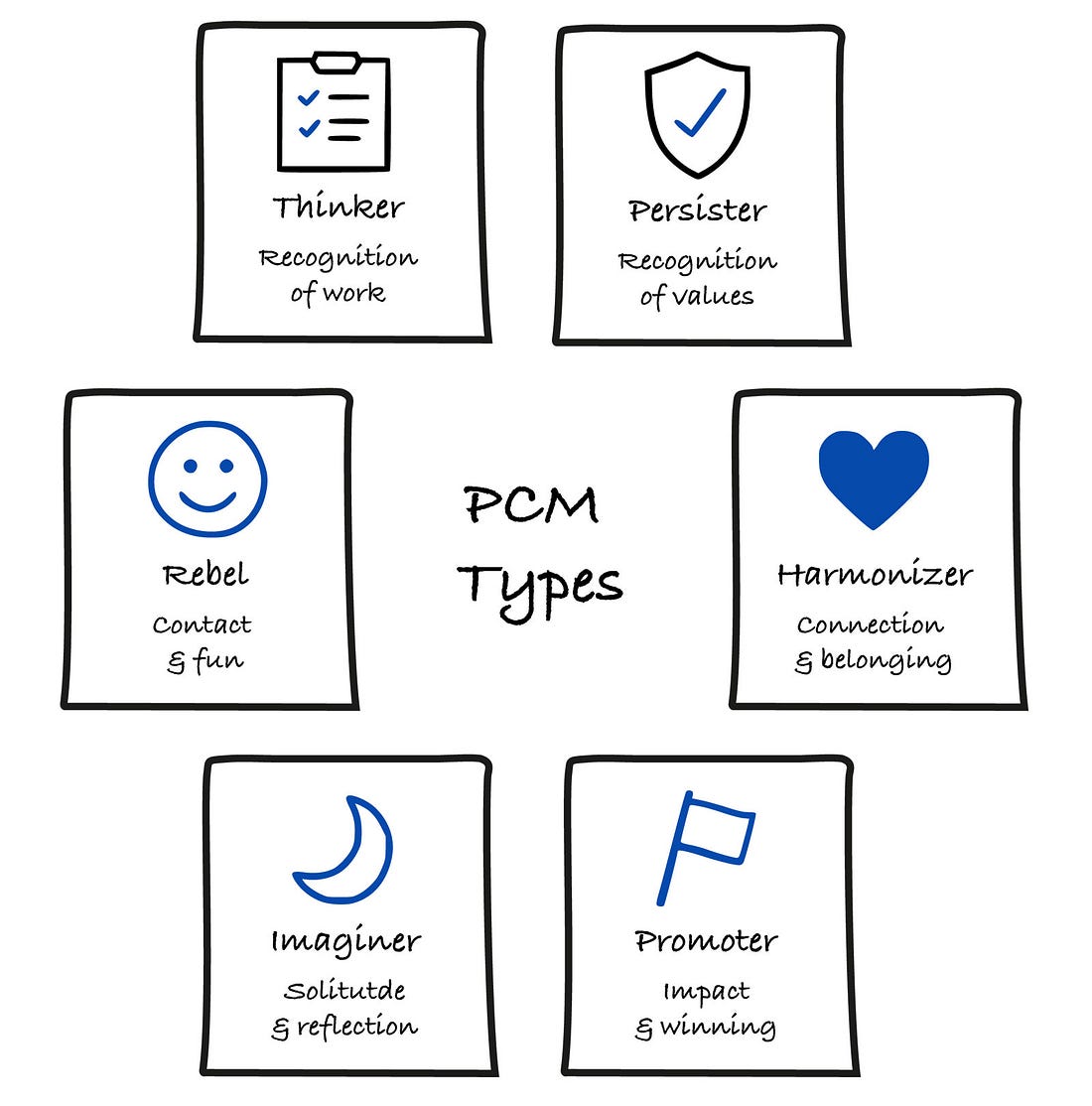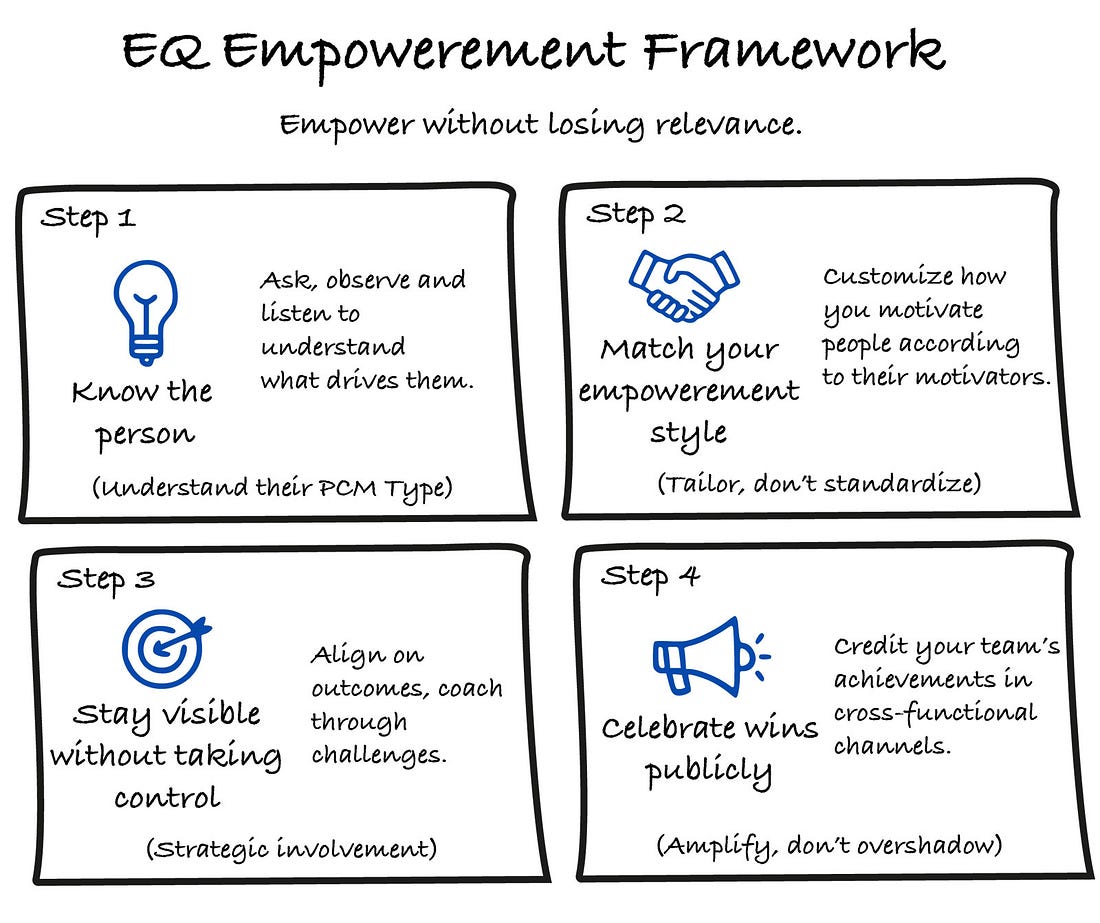How to Stay Relevant as an Engineering Leader While Empowering Others
- Gregor Ojstersek and Djordje Mladenovic from Engineering Leadership <gregorojstersek@substack.com>
- Hidden Recipient <hidden@emailshot.io>
Hey, Gregor here 👋 This is a free edition of the Engineering Leadership newsletter. Every week, I share 2 articles → Wednesday’s paid edition and Sunday’s free edition, with a goal to make you a great engineering leader! Consider upgrading your account for the full experience here. How to Stay Relevant as an Engineering Leader While Empowering OthersAdjusting the way you empower based on 6 personality types is key!This week’s newsletter is sponsored by DX. How 18 Top Companies Measure AI’s Impact on Engineering Written by Laura Tacho, CTO at DX, this new industry report explores how 18 engineering organizations—including Dropbox, Microsoft, GitHub, Atlassian, Adyen, Booking.com, and Grammarly—are measuring AI’s impact on software development. Inside this report, you’ll learn:
Thanks to DX for sponsoring this newsletter, let’s get back to this week’s thought! IntroI’ve defined in the previous article called: This Is Holding Most Engineers Back from Lead Roles, that trusting and empowering others is one of the hardest mindset shifts engineers need to make in order to grow to lead roles. FROM: How can I be the best in my craft? And having a good balance is key here! You can’t just completely let everything go, and you also shouldn’t be in all the fine details and risk being a micromanager. Lucky for us, we have Djordje Mladenovic with us today. He is sharing how to find that balance in today’s article. There are a lot of great details in this article, so it’s worth storing it and referring back to when needed, especially:
Introducing Djordje MladenovicDjordje Mladenovic is a leadership coach and Senior Engineering Manager with 15+ years in tech and over a decade leading teams. He’s coached 30+ engineering leaders to grow their emotional intelligence, navigate tough leadership moments, and lead with confidence. He is also an author of The Chronicles of a High-EQ Leader → a weekly newsletter filled with various frameworks and insights on EQ. This is our second collab with Djordje, you can check the first one here: Let’s get started! Every Leader Should Be Creating LeadersOne of the biggest responsibilities of a leader is to create other leaders. We’re taught to give our people more ownership, trust them to make decisions, and help them grow. But here’s the hidden paradox:
You might catch yourself thinking:
This tension is real, and it often pushes leaders into two unhelpful extremes: 1. Micromanaging to stay “in control”: You review every decision, insert yourself into every detail, and end up slowing your team down. 2. Disappearing to “let them lead”: You step back too far, thinking you’re empowering them, but risk becoming invisible or disconnected. Neither extreme works.
Because leadership isn’t about doing less. It’s about creating space for others to grow, while showing up where you add the most value. The EQ Side of EmpowermentEmpowering people isn’t just a leadership tactic → It’s an emotional shift that challenges how many of us define our value as leaders. Most engineering leaders grow into leadership roles after years of being individual contributors. Our careers are built on technical expertise, hands-on problem-solving, and personal delivery. Naturally, we learn to measure our worth by what we produce. But when you step into leadership, that changes. Suddenly, your success is no longer tied to what you deliver personally → it’s tied to what your people deliver through you. That transition sounds simple on paper, but feels deeply personal in practice. It can trigger a range of fears:
These fears are normal. They happen because empowerment challenges one of our core needs as leaders → the need to feel relevant. Why Emotional Intelligence MattersEmpowerment isn’t just about delegating tasks. It’s about how you make people feel when you give them ownership. This is where emotional intelligence becomes critical: 1. Self-awareness You need to understand your own triggers. Do you step in because the team truly needs support, or because it feels uncomfortable to let go? 2. Empathy Not everyone experiences empowerment the same way. Some team members thrive on full autonomy, while others freeze without guidance. Treating them all the same doesn’t work. Your relevance as a leader isn’t defined by how many tasks you control but by the trust you build. When people know you have their back, they seek your input naturally → you don’t have to fight to stay involved. What Happens Without EQLeaders who struggle with emotional intelligence often fall into predictable patterns:
Neither extreme works. The goal isn’t to do less or to do more → it’s to do the right things. When you lead with EQ, empowerment becomes a partnership. Your people feel seen, trusted, and safe to take ownership, while you remain strategically involved where your leadership has the highest impact: setting direction, aligning priorities, and creating clarity. This sets the stage for Process Communication Model (PCM), which takes emotional intelligence a step further by giving you a practical lens to understand what drives different personality types. With PCM, empowerment stops being a one-size-fits-all concept and becomes personalized leadership. Understanding PCMOne of the biggest mistakes leaders make when empowering others is assuming there’s a single right way to do it. We often try to apply a “one-size-fits-all” approach: we give everyone the same level of autonomy, the same type of recognition, and the same kind of feedback. But people aren’t the same. What motivates one person might completely overwhelm another. What feels empowering to one personality type might actually create anxiety for someone else. This is where the Process Communication Model (PCM) becomes incredibly powerful. What PCM Is and Why It MattersPCM is a framework originally developed by Dr. Taibi Kahler to better understand human behavior, communication styles, and intrinsic motivators. It identifies six personality types that exist in all of us to varying degrees. Each type has:
And what actually makes them feel empowered and trusted As leaders, understanding these patterns gives us a huge advantage → it allows us to tailor empowerment to each individual instead of assuming everyone wants the same thing. The Six PCM Personality Types1. The Thinker
2. The Persister
3. The Harmonizer
4. The Rebel
5. The Imaginer
6. The Promoter
Why PCM Changes the Empowerment GameOnce you understand what drives each personality type, empowerment stops being random → it becomes intentional and personalized.
PCM gives you the roadmap for tailoring your leadership approach based on how people are wired. When you combine this with emotional intelligence, you unlock a much higher level of influence: you don’t just give autonomy, you give it in the way that motivates them most. This is the foundation for our EQ Empowerment Framework → a practical, four-step process to empower people effectively without losing your own relevance as a leader. The EQ Empowerment FrameworkEmpowering your team isn’t just about delegating tasks. It’s about building trust, matching autonomy to individual motivators, and staying strategically visible as a leader. This four-step framework connects emotional intelligence with the Process Communication Model (PCM) → giving you a practical way to empower different personality types while maintaining your influence. Step 1: Know the Person (Understand their PCM type)Before you can empower effectively, you need to understand what drives each person:
EQ Tip: Be curious before assuming. Ask, observe, and listen to understand where they shine and what energizes them. Step 2: Match Your Empowerment Style (Tailor, don’t standardize)Once you know their motivators, customize empowerment:
EQ Tip: Empowerment isn’t always about more autonomy. Sometimes it’s about giving the right kind of ownership. Step 3: Stay Visible Without Taking Control (Strategic involvement)Here’s where most leaders struggle: how do you empower others without fading into the background? The answer isn’t micromanaging. It’s intentional visibility:
EQ Tip: Your relevance comes from creating direction and removing obstacles, not controlling tasks. Step 4: Celebrate Wins Publicly (Amplify, don’t overshadow)Recognition builds trust, motivates your team, and importantly, keeps you visible as a leader who creates other leaders.
EQ Tip: When you position yourself as the leader who grows other leaders, your influence scales far beyond your direct contributions. Why This Framework Works
In the next section, we’ll bring this to life with real-world scenarios → showing how different PCM types respond to empowerment, where leaders go wrong, and how to fix it using emotional intelligence. Real-World ScenariosEach story below shows how a common leadership mistake can be transformed through the EQ Empowerment Framework → using self-awareness, personality insight, and intentional empowerment to build trust and grow your team. 1. The Thinker → Empowering Through OwnershipScenario: EQ Mistake: Using the EQ Empowerment Framework:
Result: Milan feels trusted, delivers faster, and you stay informed without hovering. 2. The Persister → Empowering Through InfluenceScenario: EQ Mistake: Using the EQ Empowerment Framework:
Result: Ana feels included, becomes a strong contributor, and helps the team deliver without compromising on standards. 3. The Harmonizer → Empowering Through ConnectionScenario: EQ Mistake: Using the EQ Empowerment Framework:
Result: He steps into more responsibility at his own pace, building confidence along the way. 4. The Rebel → Empowering Through CreativityScenario: EQ Mistake: Using the EQ Empowerment Framework:
Result: Jovana feels energized, brings innovation to the project, and respects the structure because she helped shape it. 5. The Imaginer → Empowering Through SpaceScenario: EQ Mistake: Using the EQ Empowerment Framework:
Result: With space to think, Viktor delivers stronger solutions and gains momentum. 6. The Promoter → Empowering Through ChallengeScenario: EQ Mistake: Using the EQ Empowerment Framework:
Result: She takes full ownership, re-engages deeply, and becomes a force multiplier on the team. Why These Stories MatterWhen you combine emotional intelligence with personality-driven empowerment, leadership becomes both more personal and more effective. ✅ You stop guessing what motivates people This is what the EQ Empowerment Framework is all about:
Final Word → The Relevance ParadoxGreat leadership isn’t about doing more or disappearing. It’s about creating an environment where your people grow, take ownership, and shine, while you stay strategically relevant by shaping vision, creating alignment, and building trust. When you combine emotional intelligence with the Process Communication Model (PCM), empowerment stops being a gamble and becomes a skill:
The paradox is this: the more you empower others intentionally, the more your own influence grows.
As engineering leaders, we have a choice: We can manage tasks and control outcomes… or we can empower people in a way that builds trust, multiplies impact, and positions us as the leader others want to follow. Take a moment to reflect:
Your answers will shape how you empower → and how you grow as a leader. Last WordsSpecial thanks to Djordje for sharing his insights on this very important topic with us! Make sure to check him out on LinkedIn and also check out his newsletter The Chronicles of a High-EQ Leader. We are not over yet! Companies Should Stop Obsessing Over AI Tools And Do This InsteadCheck out my latest video. The topic of the latest video is something that has been on my mind for quite a while. I am seeing many companies obsessing over shiny AI tools, but they are forgetting that there are a LOT more important things to take care of. 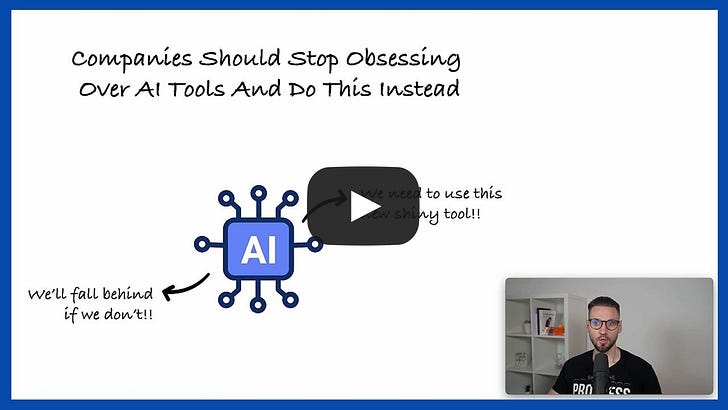 New video every Sunday. Subscribe to not miss it here: Liked this article? Make sure to 💙 click the like button. Feedback or addition? Make sure to 💬 comment. Know someone that would find this helpful? Make sure to 🔁 share this post. Whenever you are ready, here is how I can help you further
Get in touchYou can find me on LinkedIn, X, YouTube, Bluesky, Instagram or Threads. If you wish to make a request on particular topic you would like to read, you can send me an email to info@gregorojstersek.com. This newsletter is funded by paid subscriptions from readers like yourself. If you aren’t already, consider becoming a paid subscriber to receive the full experience! You are more than welcome to find whatever interests you here and try it out in your particular case. Let me know how it went! Topics are normally about all things engineering related, leadership, management, developing scalable products, building teams etc. You're currently a free subscriber to Engineering Leadership. For the full experience, upgrade your subscription. |
Similar newsletters
There are other similar shared emails that you might be interested in:
